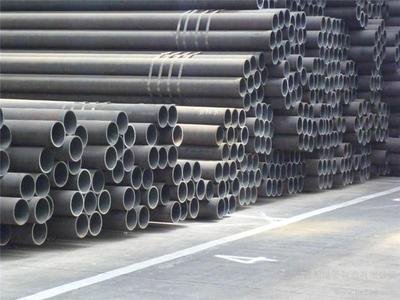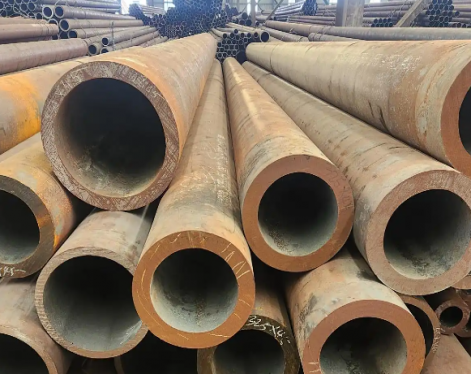Carburizing is a surface heat treatment technology, which refers to the heat treatment method of quenching after expanding carburizing atoms on the surface of seamless pipes. By increasing the carbon content on the surface of the seamless pipe, the wear resistance, durability, toughness and other properties of the seamless pipe can be significantly improved.
The main heat treatment process of carburized seamless pipe is generally quenching and low temperature tempering after carburizing. The core of the steel pipe after treatment is a low-carbon martensite structure with sufficient strength and toughness, and the surface layer is hard and wear-resistant tempered martensite and a certain amount of fine carbide structure.
According to the working conditions, the seamless pipe is required to have high surface hardness and wear resistance, while the core requires high strength and appropriate toughness, that is, the performance of the workpiece is required to be "hard on the outside and tough on the inside".
In order to take into account the above dual performance, it can be achieved by carburizing, quenching and low-temperature tempering by using low-carbon seamless pipes. At this time, the core of the steel pipe is a low-carbon steel quenched structure, which ensures high toughness and sufficient strength, while the surface layer (at a certain depth) has a high carbon content (0.85% to 1.05%). After quenching, it has high hardness (HRC>60), and can obtain good wear resistance.

Composition characteristics of carburized seamless pipe
1. The carbon content of carburized seamless pipes is generally very low (between 0.15% and 0.25%), which belongs to low-carbon steel pipes. Such carbon content ensures that the core of carburized steel pipes has good toughness and plasticity.
2. In order to improve the strength of the core of the steel pipe, a certain amount of alloying elements can be added to the steel, such as Cr, Ni, Mn, Mo, W, Ti, B, etc.
3. Among them, the main function of alloying elements such as Cr, Mn, Ni is to increase the hardenability of the steel pipe, so that the surface layer and core structure can be strengthened after quenching and low temperature tempering.
4. A small amount of carbide-forming elements such as Mo, W, Ti, etc. can form stable alloy carbides, which can refine grains and inhibit overheating of steel pipes during carburizing.
5. Trace amounts of B (0.001% to 0.004%) can strongly increase the hardenability of alloy carburized steel pipes.
The main heat treatment process of carburized seamless pipe is generally quenching and low temperature tempering after carburizing. The core of the steel pipe after treatment is a low-carbon martensite structure with sufficient strength and toughness, and the surface layer is hard and wear-resistant tempered martensite and a certain amount of fine carbide structure.
According to the working conditions, the seamless pipe is required to have high surface hardness and wear resistance, while the core requires high strength and appropriate toughness, that is, the performance of the workpiece is required to be "hard on the outside and tough on the inside".
In order to take into account the above dual performance, it can be achieved by carburizing, quenching and low-temperature tempering by using low-carbon seamless pipes. At this time, the core of the steel pipe is a low-carbon steel quenched structure, which ensures high toughness and sufficient strength, while the surface layer (at a certain depth) has a high carbon content (0.85% to 1.05%). After quenching, it has high hardness (HRC>60), and can obtain good wear resistance.

Composition characteristics of carburized seamless pipe
1. The carbon content of carburized seamless pipes is generally very low (between 0.15% and 0.25%), which belongs to low-carbon steel pipes. Such carbon content ensures that the core of carburized steel pipes has good toughness and plasticity.
2. In order to improve the strength of the core of the steel pipe, a certain amount of alloying elements can be added to the steel, such as Cr, Ni, Mn, Mo, W, Ti, B, etc.
3. Among them, the main function of alloying elements such as Cr, Mn, Ni is to increase the hardenability of the steel pipe, so that the surface layer and core structure can be strengthened after quenching and low temperature tempering.
4. A small amount of carbide-forming elements such as Mo, W, Ti, etc. can form stable alloy carbides, which can refine grains and inhibit overheating of steel pipes during carburizing.
5. Trace amounts of B (0.001% to 0.004%) can strongly increase the hardenability of alloy carburized steel pipes.









